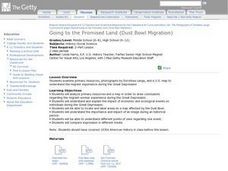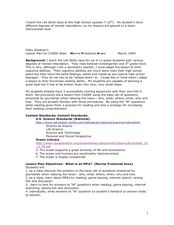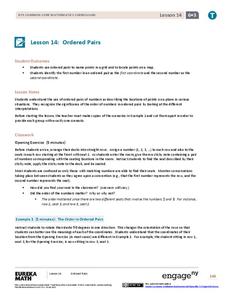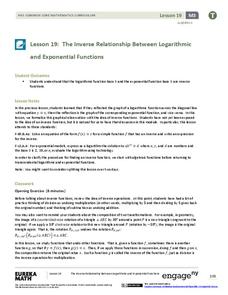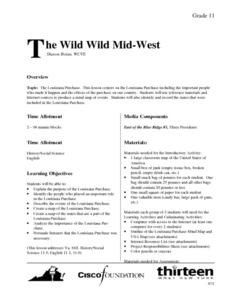Curated OER
Studying Locally, Teaching Globally
Young scholars work in small groups to create outlines and mind-maps that demonstrate their understanding of the effects of outsourcing on economic relationships and the U.S. economy.
Curated OER
History-Causes of WW I
Seventh graders participate in a class discussion about what caused World War II. Working in groups, they identify the reasons they believe were most important in starting the war and present their reason in the form of a PowerPoint,...
Curated OER
The Rock Family
Students research the characteristics of igneous, sedimentary and metamorphic rocks using the Internet. They evaluate websites for use before they organize the research information into a table. They use software to complete a concept map.
Curated OER
A Differentiated Way through Think Dots
Learners examine reasons that led people to explore, identify "West" as defined following Revolutionary War, explain importance of finding natural resources, develop time line of dates and events leading up to Lewis and Clark Expedition,...
Curated OER
The Vision of the City in the Mind's Eye, 12501700
Pupils create their own symbols for a city from other letters of the alphabet (or geometric shapes). They rotate the letters to explore their possibilities. Corporate logotypes and other trademarks make excellent examples for this activity.
Curated OER
Map the Path in My Father's Dragon
Students listen to Ruth Stiles Gannett's book My Father's Dragon. They predict the outcome of the story. They discuss the events in the story. They sequence the events in the story.
Curated OER
Fate vs. Mind: A Macedonian Folk Tale
Learners examine the work of Carla Bachechi as a Peace Corp volunteer in Macedonia. Individually, they read various folktales from the country and break into groups to discuss how it is different than a novel. To end the lesson, they...
Curated OER
Where are the Watersheds in San Francisco?
Students create a mental map of San Francisco. They compare it with actual topographical maps of the city. Then they label various locations on the San Francisco Hillshade map and locate watershed boundaries.
Curated OER
Looking Back to 1980
Pupils use clustering/mind mapping techniques to generate ideas, graphically represent inferences, organize their conclusions and write a report that presents conclusions the writer has reached, and facts substantiating those conclusions.
Curated OER
Subsidies and Taxes
Students utilize supply and demand models to demonstrate how markets can be affected by intervention from governments or other agencies in an attempt to correct a perceived market failure. After viewing a PowerPoint presentation,...
Curated OER
Ways We Use Water
Fourth graders write a persuasive paper after a demonstration about the properties of water and how they work. The lesson also uses a mind map to outline the paper.
Curated OER
Number the Stars, Lesson 3
Students consider how an author creates a feeling of suspense in a reader's mind. They analyze characters in the story. Students make a character map for Peter. They discuss how suspense unfolds in the novel Number the Stars.
Curated OER
Going to the Promised Land
Students analyze primary resources and map in order to draw conclusions regarding the migrant-worker experience during the Great Depression. They explain and explain the impact of economic and ecological events on individuals.
Curated OER
Life During the Civil War for Women and Civilians
Students follow an overview of the American Civil War from a film, the text and/or teacher direct instruction. They create a timeline with a large map of the U.S. in the 1860's available for student reference as they do the spider activity.
Curated OER
Let's Get the Facts!
Young scholars observe and demonstrate the process of summarization. They discuss the three steps of summarization, then silently read a National Geographic Kids News article. As a class they complete a semantic map of the article, and...
Curated OER
Twain: Steamboat's a-Comin'
Young scholars discover how rivers inspire creative expression. In this Mark Twain lesson, students list songs about rivers and discuss common characteristics. They locate the Mississippi River on a map and write a script in which a...
Curated OER
Marine Protection Areas
Learners explain the importance of having Marine Protected Areas. In this ecology lesson plan, students research MPA's in any of the Great Lakes. They play a MPA simulation game and identify MPA's on the map.
EngageNY
Ordered Pairs
Scholars learn to plot points on the coordinate plane. The lesson introduces the idea that the first coordinate of a coordinate pair represents the horizontal distance and the second coordinate represents the vertical distance.
EngageNY
The Inverse Relationship Between Logarithmic and Exponential Functions
Introducing inverse functions! The 20th installment of a 35-part lesson encourages scholars to learn the definition of inverse functions and how to find them. The lesson considers all types of functions, not just exponential and...
Hastings Prince Edward Public Health
What is Health?
Many indicators of health are beyond a teenager's control, but there are many changes they can make in their daily life that can improve their health. Middle schoolers think about their physical, social, and mental health status before...
National Endowment for the Humanities
The Creation of the Bill of Rights: “Retouching the Canvas”
While the Constitutional Convention lay the foundation of the new government for the United States, the protections given under the Bill of Rights were controversial. Using documents, such as James Madison's and Thomas Jefferson's...
Curated OER
The Wild Wild Mid-West
Eleventh graders examine reasons for Louisiana Purchase and identify those who played key roles in it, create map of Louisiana Purchase and states that are part of it, and analyze overall importance of Louisiana Purchase.
Curated OER
Skeletal, Skin, and Muscular Systems
Eighth graders explain the functions of various body systems. Using a concept map, 8th graders identify and explain the fuctions of the skeletal, skin, and muscular systems of the body. After completing their concept map, students...
Curated OER
Discipline vs. Self-Discipline
Students explore self-discipline. For this character education lesson, students define and give examples of discipline and self-discipline. Students work with a group to complete a related concept map.
Other popular searches
- Mind Mapping Math
- Brainstorming Mind Mapping
- Mind Mapping a Story
- Mind Mapping Note Taking
- Mind Mapping Energy
- Mind Mapping Lesson History
- Listening Mind Mapping
- Mind Mapping Lesson
- Mind Mapping Problem Solving
- Mind Mapping Lesson Plan
- Mind Mapping and Newspaper














